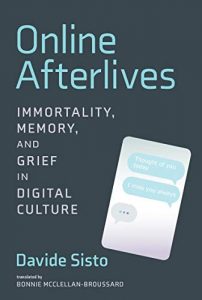In Online Afterlives: Immortality, Memory and Grief in Digital Culture, Davide Sisto explores how digital technologies have come to impact our relationship with death, traversing the numerous digital devices and practices that are shaping mourning and grief today. Illustrated by multiple real-world examples and supported by relevant literature, this book offers an excellent introduction to death and digital culture, finds Mona Oikarinen.
Online Afterlives: Immortality, Memory and Grief in Digital Culture. Davide Sisto (translated by Bonnie McClellan-Broussard). MIT Press. 2020.
 Find this book (affiliate link):
Find this book (affiliate link): ![]()
‘Thanks to these digital ghosts, we can easily mingle with communicable traces of the dead while at the same time this very interaction makes it difficult for us, the living, to distinguish communication at a distance from communication with the dead.’
Though you would be forgiven for mistaking these lines for science fiction, in reality they come from Italian theoretical philosopher Davide Sisto’s Online Afterlives: Immortality, Memory and Grief in Digital Culture. As can be deduced from its title, Sisto’s book considers whether and how digital technologies might come to impact our relationship with death. It provides an excellent introduction to thanatechnology by reviewing key publications in the field and by introducing the reader to the numerous digital devices and practices available to those grieving today. From chatbots and holograms to QR codes on tombstones and private messaging with the dead, the author frames these new and somewhat strange inventions in the context of our human and historical quest to make sense of death and our own mortality.
The introductory chapter of the book outlines Sisto’s general approach to technology. Resisting sensationalist narratives, he argues against technological determinism and maintains that most positive and negative effects of technology use derive from the ways in which they are employed by their users, rather than the technologies themselves. Sisto encourages us to be mindful of the ways in which we use digital technologies, while portraying the situation in which we find ourselves today sensibly as the result of decades of technological development, as well as of our desire to make sense of the human condition, including our mortality.

Photo by Ales Nesetril on Unsplash
Chapter One opens with the story of ‘Be Right Back’, a 2013 episode of the British television series Black Mirror. After the death of her fiancé, a young woman installs an app on her phone that allows her to keep communicating with a digital replica of her partner that has been constructed from his social media posts. Sisto explains that today, less than a decade later, this storyline is no longer a mere science fiction fantasy: novel innovations such as chatbots and holograms have made communication with the dead a reality. While the author cautions against over-reliance on any of these technologies as he believes that they may interfere with the grieving process, he argues that when used in moderation, they can be helpful in comforting those in the immediate aftermath of a tragic loss.
The second chapter considers the erasure of death in the Western world and the ways in which online social networks could help open up a conversation on death and reconnect us to the lost communal dimensions of mourning. Sisto takes Chris Cornell’s suicide as an example of how death can be discussed in a helpful way online. He recounts how the singer’s tragic death started a broader conversation on mental illness and helped to raise awareness of topics such as suicide prevention. Nonetheless, the author reminds us that this is not an inevitable effect of social networks, but rather depends on our use of them. Death could just as easily become trivialised online, if we allow the news of a person’s death, for example, to become swallowed into a constant, fast-paced stream of content.
Unlike the previous two chapters that each tackle a single, specific element of death and digitality, the third chapter touches on many disparate elements of digital culture. From QR codes on tombstones to the livestreaming of and the taking of selfies at funerals, Sisto’s argument remains that depending on the ways in which these modern, digital innovations are put to use, they are capable of both positive and negative effects. For example, while livestreaming a funeral can enable those far away to attend, it can also potentially have the effect of making us increasingly desensitised to death.
The afterword summarises Sisto’s perspective on the effects of modern digital technologies on the grieving process and on our relationship with our own mortality. He argues that the digital age has provided us with an opportunity to work on our relationship with death. In the twentieth century, the dead became increasingly confined to cemeteries and the dying to hospitals. The ways in which the internet can bring death back into view in our daily lives, such as when we receive a Facebook notification of the birthday of someone who has passed away, could begin to change this. However, if we are not careful with how we use these technologies, they can also have negative effects, such as in interrupting the grieving process or making us feel increasingly detached from death.
Sisto’s book is particularly suitable to those who have not yet thought in depth about the ways in which digital technologies may come to affect our relationship with death and mourning. All the phenomena discussed in the book are illustrated with multiple real-life examples and supported by relevant literature from the field of thanatechnology. This makes the book an excellent introduction to death and digital culture.
- This article originally appeared at the LSE Review of Books.
- Please read our comments policy before commenting.
Note: This article gives the views of the authors, and not the position of USAPP– American Politics and Policy, nor of the London School of Economics.
Shortened URL for this post: https://bit.ly/3wKTuBd
About the reviewer
Mona Oikarinen – University of Edinburgh
Mona Oikarinen is a Master’s by Research student in Sociology at the University of Edinburgh. Her research concerns music, society and technology.






